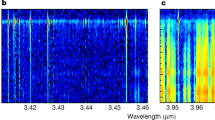Abstract
THE detection of a cloud of neutral sodium near Jupiter's moon Io1 has led to the use of sodium as a tracer of processes in the jovian environment. Although relatively rare in the Io–Jupiter system, sodium atoms are easily detected because of their high efficiency for scattering sunlight at wavelengths of ∼5,890 Å. Direct imaging of the sodium cloud2 has suggested that sodium atoms are a common feature close to Io (at distances of about six Io radii, RIo) and detection of high-speed sodium jets3 suggested that sodium is present only sporadically at ∼30/RIo (ref. 4). Sodium emission has been reported at greater distances5, even as far as 60RIo (ref. 6) but these observations have been controversial in view of suggestions7 that the detection of sodium beyond ∼10RIo was implausible on theoretical grounds and probably indistinguishable from terrestrial sodium airglow. Here we report on the detection of sodium to distances beyond ∼400 RI, an observation that requires the ejection rate of sodium atoms to be increased. By relating the shape of this great nebula to conditions in the plasma torus surrounding Jupiter, we show that ground-based imaging techniques can provide information about distant planetary magnetospheres.
Similar content being viewed by others
Change history
28 February 1991
An Erratum to this paper has been published: https://doi.org/10.1038/349811a0
References
Brown, R. A. in Proc. IAU Symp. 65, Exploration of the Planetary Systems (eds Woszczyk, A. & Iwaniszewska, C.) 527–531 (Reidel, Dordrecht, 1974).
Goldberg, B. A., Garneau, G. W. & LaVoie, S. K. Science 226, 512–516 (1984).
Trauger, J. T. Science 226, 337–341 (1984).
Schneider, N. M., Smyth, W. H. & McGrath, M. A. Time-Variable Phenomena in the Jovian System. SP-494 (eds Belton, M. J. S., West, R. A. & Jurgen, R.) 75–94 (NASA, Washington, 1989).
Pilcher, C. B. & Schempp, W. V. Icarus 38, 1–11 (1979).
Trafton, L. & Macy, W. Jr Icarus 33, 322–325 (1978).
Goody, R. & Apt, J. Planet. Space Sci. 25, 603–604 (1977).
Baumgardner, J. Eos 70, 404 (1989).
Baumgardner, J. & Karandanis, S. Electronic Imaging 3, 28–31 (1984).
Brown, R. A. & Schneider, N. M. Icarus 48, 519–535 (1981).
Wehinger, P. A., Wyckoff, S. & Frohlich, A. Icarus 27, 425–528 (1976).
Kirchhoff, V. W. J. H. Can. J. Phys. 64, 1664–1672 (1986).
Reynolds, R. J. & Ogden, P. M. Astrophys. J. 229, 942–953 (1979).
Pilcher, C. B., Smyth, W. H., Combi, M. R. & Fertel, J. H. Astrophys. J. 287, 427–444 (1984).
Schneider, N. thesis, Univ. Arizona (1988).
Bagenal, F. in Time-Variable Phenomena in the Jovian System. SP-494 (eds Belton, M. J. S., West, R. A. & Jurgen, R.) 196–210 (NASA, Washington, 1989).
Roelof, E. C. & Williams, D. J. Johns Hopkins APL Tech. Digest 9, 72–76 (1990).
Author information
Authors and Affiliations
Rights and permissions
About this article
Cite this article
Mendillo, M., Baumgardner, J., Flynn, B. et al. The extended sodium nebula of Jupiter. Nature 348, 312–314 (1990). https://doi.org/10.1038/348312a0
Received:
Accepted:
Issue Date:
DOI: https://doi.org/10.1038/348312a0
- Springer Nature Limited
This article is cited by
-
Chemical Composition of Icy Satellite Surfaces
Space Science Reviews (2010)
-
Atmospheric/Exospheric Characteristics of Icy Satellites
Space Science Reviews (2010)
-
Effects of the External Environment on Icy Satellites
Space Science Reviews (2010)
-
The Use of Small Telescopes for Spectral Imaging of Low-light-level Extended Atmospheres in the Solar System
Earth, Moon, and Planets (2009)
-
Exospheres and Atmospheric Escape
Space Science Reviews (2008)





